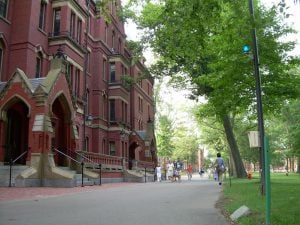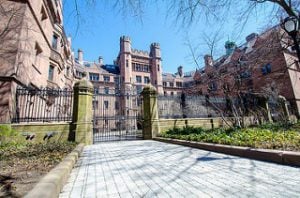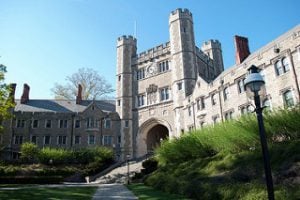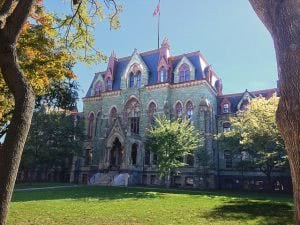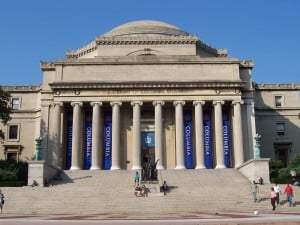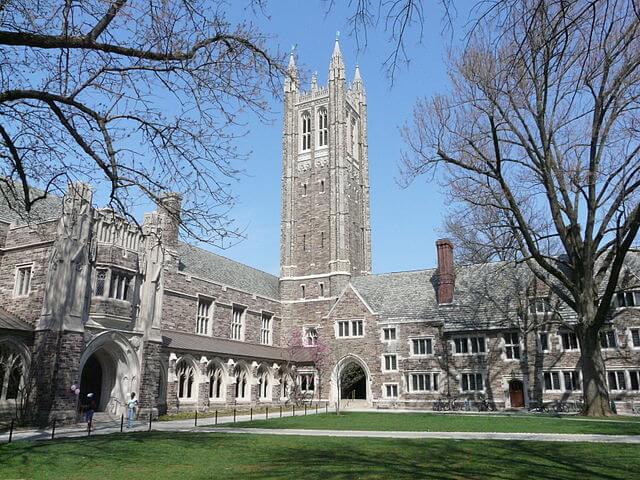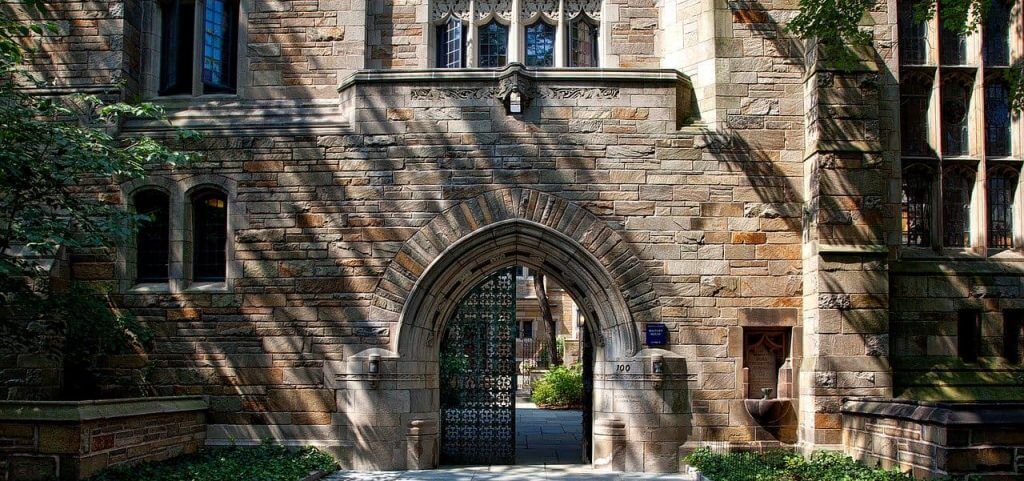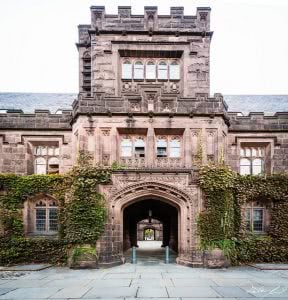
Flickr user Dieter Weinelt
If you’re thinking about applying to an Ivy League school, you’re probably wondering why they are called Ivy League schools. While the term Ivy League refers to the eight elite research universities that make up the Ivy League sports conference – Harvard University, Yale University, University of Pennsylvania, Princeton University, Columbia University, Brown University, Dartmouth College, and Cornell University, the phrase’s meaning and origins are less clear.
So why are they called the Ivy League schools? Well, the term actually dates back to the 1930s when a sports writer coined the phrase. Take a trip back in time with us to see exactly what makes a school an Ivy League and why they’re called Ivy League in the first place.
What Makes an Ivy League School Different From Others?
Each of the Ivy League colleges have outstanding sports programs, but today the phrase “Ivy League” is more synonymous with “elite school” than “football” for most students.
Each of the 8 schools in the conference today are known for their competitive admission cycles, research programs, famous alumni, exemplary academic programs, historic and beautiful campuses, libraries, museums, and more.
Ivy League Schools: Quick Facts
| Ivy League School | Location | Current Rank | Admission Rate | Sticker Price |
| Harvard University | Cambridge, MA | #1 | 3% | $82,950 |
| Yale University | New Haven, CT | #4 | 5% | $88,171 |
| University of Pennsylvania | Philadelphia, PA | #9 | 7% | $79,893 |
| Princeton University | Princeton, NJ | #2 | 6% | $80,110 |
| Columbia University | New York, NY | #8 | 4% | $83,431 |
| Brown University | Providence, RI | #11 | 5.1% | $85,789 |
| Dartmouth College | Hanover, NH | #15 | 6.5% | $84,119 |
| Cornell University | Ithaca, NY | #20 | 7.5% | $81,912 |
Why Are the Ivy League Schools Called the “Ivy League?”
When talking about “Ivy League schools,” you likely think of elite colleges. And while that is true, the name actually originates from football!
The reason Ivy League schools are called “Ivy League” likely dates back to the 1930s. The “ivy” association with the schools was used by Stanley Woodward who wrote in the New York Herald Tribune. As the story goes, Woodward was annoyed that he had to cover Columbia University playing football against University of Pennsylvania rather than his alma mater (Fordham) and referred to Columbia and schools in the conference as those old “ivy-covered” universities to his editor.
So Why Did Woodward Call Them “Ivy Colleges?”
The first time the phrase saw print was when Woodward wrote an October 1933 article and included the line, “The fates which govern play among the ivy colleges and the academic boiler-factories alike seem to be going around the circuit these bright autumn days cracking heads whenever they are raised above the crowd.”
This line was in reference to the football season of various schools including Harvard, Princeton, Columbia, Yale, the United States Military Academy, and the United States Naval Academy. This group of colleges already had long-standing football traditions.
In 1935, the term “Ivy League” would specifically be used by The Christian Science Monitor. The term would be synonymous with “older colleges.”
During 1936, the original Ivy League schools would come together in an effort to maintain common interests when it came to sports.
But why are the Ivy League schools called the Ivy Leagues even today? Why did the name stick? In 1945, the colleges would sign the Ivy Group Agreement. This set standards for the football teams and, in later years, it would pertain to other sports. The League was officially founded in 1954, with the first year of competition in 1956.
Today, eight colleges of the Ivy League compete in the Ivy Group for Football, Baseball, Basketball, and Cross Country/Track.
What About the “IV League” Theory?
There is one myth that tends to be perpetuated when it comes to the Ivy League schools’ name: that it actually originated from the Roman numeral for four. This rumor is built on the idea that the conference originally had four members. Although this is an interesting theory, there is no real proof that this is where the name came from.
What Schools Are in The Ivy League Today?
There are eight Ivy League schools today. They are regularly named to the top 50 schools in the country and all have outstanding programs, resources, and opportunities for their students. Today, the Ivy Leagues are:
Harvard University
Harvard University was originally known as Harvard College, named so for clergyman John Harvard. It was founded in 1636, offered its first classes in 1642, and chartered in 1650. With a 98% first-year retention rate, students today experience a 7:1 student-to-faculty ratio and 87% will graduate within 4 years.
Students are known as the Crimson and the athletes, wearing crimson, white, and black are cheered on by their mascot and namesake, John Harvard.
Yale University
Yale University was originally known as the Collegiate School and was meant to educate Calvinist Congregational ministers. Founded and chartered in 1701, the school originally only taught theology and sacred languages. Today, the most popular major at this Ivy League school is Econometrics and Quantitative Economics followed by History and Political Science and Government.
Known as the Bulldogs, Yale athletes wear Yale Blue and their mascot is Handsome Dan (who, of course, is a bulldog!). The current Handsome Dan is the 19th (XIX).
Princeton University
Princeton University, first known as the College of New Jersey and located in Princeton, was founded and chartered in 1746. The first courses would be offered the following year. They would get their current moniker in 1896. Princeton boasts a 97% first-year retention rate and a 5:1 student-to-faculty ratio.
Princeton students and athletes are known as the Tigers and (it should come as no surprise) wear orange and black. Their mascot is The Tiger.
University of Pennsylvania
Also known as Penn or UPenn, this Ivy League school was founded under the name College of Philadelphia in 1740 by Benjamin Franklin. The early courses offered by the school were not focused on the clergy, but instead focused on overall higher education. It would be renamed University of Pennsylvania in 1791. University of Pennsylvania currently has over 28,000 students attending and an 8:1 student-to-faculty ratio.
The Quakers wear red and blue and the mascot is aptly named “The Quaker.”
Columbia University
Originally called the King’s College, Columbia University was founded and chartered in 1754, with the first classes opening the same year. It’s the oldest institution of higher education in New York! The Ivy League school would become Columbia College in 1784 and Columbia University in 1896. Today, the most popular majors among students include Computer Science, Econometrics and Quantitative Economics, and Political Science and Government.
Columbia University students and athletes are called the Lions and wear Columbia blue and white. Roar-ee the Lion cheers them on from the sidelines.
Brown University
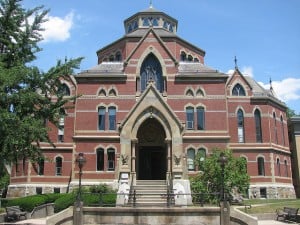
Source: Flickr user dlthurston.
Brown University was first known as the College in the English Colony of Rhode Island and Providence Plantations or Rhode Island College. The future Ivy League school was founded in 1764. And, although its founding was by Baptists, it was actually the first college on the continent that accepted students regardless of their religious affiliation.
The Bears wear seal brown, cardinal red, and white when they compete in the Ivy League and their mascot is known as Bruno the Bear.
Dartmouth College
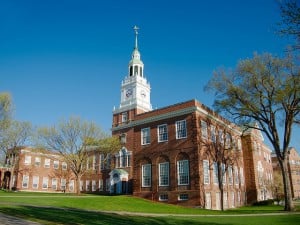
Source: Flickr user sarunas_b.
Dartmouth College, in Hanover, New Hampshire, founded in 1769, originally opened to teach Native Americans about Christian theology and English ways of life in an effort to turn them into missionaries. The school changed over the years before getting a major facelift at the turn of the 20th century and becoming nationally known.
Athletes at this Ivy League school are known as the Big Green and wear Dartmouth Green and white. The college has been without an official mascot for decades.
Cornell University
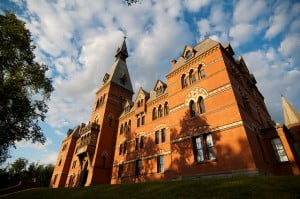
Source: Flickr user 30416747@N00.
Founded in 1865 by Ezra Cornell and Andrew Dickson White, classes started at Cornell University in 1868. All areas of study were available at this Ivy League school from day one. Today, the university has satellite campuses in New York City and Qatar, has a 9:1 student-to-faculty ratio, and a 97% first-year retention rate.
Known as the Big Red, students and athletes wear red and white. Cornell’s unofficial mascot is currently Touchdown the Bear or Big Red Bear.
Every Ivy League school has a unique and rich history, and the entire reason they’re known as “Ivy League schools” today dates back to an almost throwaway line about their football programs! But the name stuck and it’s unlikely to go anywhere any time soon.
Do you know what the Ivy League schools look for out of applicants? Each one is highly selective, so it’s essential that you have a game plan and know what to expect. Using our College Match tool, you can find out which universities or colleges best fit you – including, hopefully, these Ivy League schools!

